Most strategy advice will tell you to be outcome focused. Understand your customer, get clear on your value proposition and put in place measurements to track your success.
I agree with all of this advice. These are essential steps.
But the strategies I am going to propose are based on first principles. They are the underlying approach you need to have in place.

They are no regrets strategies because they are foundational. With these in place, all of your other strategies will be better.
Your API product strategies will need to be tailored to your outcomes. These are enterprise strategies that are suitable for any context.
Even though they are no regret strategies, they can be challenging to implement. That’s because we’ve grown up in a monolithic world.
Part 1 of this series outlined how the traditional management strategies you learned in your MBA are based on monolithic structures.
When it comes to the micro service network of APIs, these are the strategies you need.

Where Do These 3 New API Strategies Come From?
As APIs become more complex and interconnected, it becomes increasingly important to apply complexity science to API strategy. Complexity science is a field of study that examines complex systems, including social, economic, and biological systems. By applying the principles of complexity science to API strategy, organisations can create more resilient and adaptive API programs that can withstand change and uncertainty.
These 3 strategies are rooted in complexity science. They take the entire API ecosystem into account. It’s a broad perspective, which considers the relationships the APIs have created and participate in between systems, data, customers. This is how they are globally and not locally optimised strategies. The following 3 strategies are not linear. They work together to support and reinforce each other.
They are to take a positive sum approach, be open and transparent. Let’s look at each in turn with specific examples of actions you can take with your APIs to apply these strategies.

Strategy 1: Positive Sum Approach to Increase Value
The first foundational shift is to take a positive sum approach. The term positive sum comes from game theory and is the opposite to a zero sum approach.
In a zero sum approach where one party wins, the other party looses. A positive sum approach is win-win. With this as a one of your first principles, you will need to focus on the following API actions.
Understand your API Ecosystem
Firstly you need to understand your API ecosystem. This is where multiple parties can benefit from sharing data and services can be a positive sum strategy. For example, a retailer could offer APIs to third-party developers to build apps that can access the retailer's product catalog, creating a win-win scenario where the retailer gets exposure to a new audience, and the developers get access to valuable data.
Consider API Partnerships
Secondly you should consider partnerships. Partnering with other companies to create integrated solutions that use APIs can be a positive sum strategy. For instance, a ride-hailing service could partner with a food delivery company to offer customers the option to order food from within the ride-hailing app. This creates a win-win scenario where both companies benefit from the partnership and customers get a more seamless experience.
Generate Value with API Monetisation
Thirdly API monetisation is a powerful way to focus on generating win-win value. Offering monetisation options for APIs, such as charging for access or taking a commission on transactions, can be a positive sum strategy. For example, a payment gateway service could offer APIs to merchants and charge a commission on every transaction processed through the API. This creates a win-win scenario where both the payment gateway service and the merchants benefit from the increased sales.
In summary, a positive sum strategy with APIs involves creating opportunities for all parties involved to benefit, such as through API ecosystems, partnerships, and API monetisation. By focusing on creating win-win scenarios, businesses can leverage APIs to create new opportunities and drive growth.

Strategy 2: Open APIs to Decrease Risk
One of the biggest concerns when it comes to APIs is security and risk. This drives the temptation to return to closed systems as a security strategy. In reality, you are more at risk if you don’t have a strategy to open your APIs. A closed system is more fragile as you have not built the muscle to share data, which is essential for modern business success.
Of course, open APIs can also present security challenges if they're not designed and implemented properly. However, done right, Open APIs allow for a far more sophisticated, nuanced and rigorous protection. As the API ecosystem grows and becomes increasingly complex, it is essential to start building your open API muscle. Here’s how.
Increased Scrutiny
When an API is open, it's available for anyone to examine and audit, which means that potential security flaws or vulnerabilities can be identified and addressed more quickly. In contrast, a closed system may only be tested by a limited number of people, which can make it more difficult to find and fix security issues.
Standardization
Open APIs are often built using standard protocols and formats, which means that security best practices can be baked into the design. This can make it easier to ensure that the API is secure from the outset. Closed systems, on the other hand, may be built using proprietary protocols and formats that can be more difficult to secure.
Access Control
Open APIs can be designed to provide fine-grained access control, which means that different levels of access can be granted to different users or applications. This can help to prevent unauthorized access and reduce the risk of security breaches. In contrast, a closed system may have more limited access control options.
On top of increased security, Open APIs are also a critical component of generating value through a positive sum approach.

Strategy 3: Transparency Increases Trust
Finally, for successful API management, you need to have transparency. Transparent APIs mean you have a clear picture of your API ecosystem. You know your portfolio of API products. You can see how they work together to form capabilities and you have a view of the broader API ecosystem they participate in. This visualisation allows for both monitoring and surveillance. It helps you identify the opportunities to increase value and highlights where you may have vulnerabilities.
Transparency holds together the other 2 strategies of generating positive-sum value and decreasing risk through open APIs. So what does transparency look like in practical terms?
API Documentation
API documentation is a critical part of any API visualization strategy. Clear, concise documentation can help developers understand how to use the API, what data it provides, and how to work with the API's various endpoints. Documentation can take many forms, including plain text, diagrams, and interactive examples.
API Data Visualisation
While APIs can package up and share data, they also provide data insights of their own. Your API logs can show you how your APIs are being used. Information like who is using your APIs, where they are located, and what data is being accessed. Making this data visible and easy to consume can provide greater transparency into how data is being used and shared, which can help to build trust with users. This can be particularly important when dealing with sensitive data, such as personal or financial information.
API Metrics
Finally, API metrics can tell a powerful story that helps you make sense of your API data. Defining API metrics is an art form in its own right. While your API data is important to present, an API metric should help you measure how your API is delivering customer and business value. Time to first call is a good piece of data to visualise. Understanding the time to first value is where your data will generate actionable insight.
As your API interactions grow, it is critical to visualise your API ecosystem.

How Treblle Can Help with Your API Strategy
Conway's Law is a famous adage in software engineering that states that "organizations which design systems... are constrained to produce designs which are copies of the communication structures of these organizations". In other words, the structure of an organization will inevitably be reflected in the design of the systems they produce.
When applying these strategies of a positive sum approach, decreasing risk with open APIs and increasing trust with transparency, consider your organisation's design. How open, transparent, and win-win is your organisation?
A tool like Treblle is invaluable to take on these API strategies. All Treblle features are specifically designed to make it easy for teams that own the API operations to maintain their APIs and make informed decisions. Some examples of this:
Logging and Analytics
From the analytics features, you get over 40 data points about every single API request. You can easily track the performance of the most important endpoints, see from where the request is coming, from which device, what is the average response size, and more.
Treblle generates an API Score which helps teams and team leads to keep the API operations on track and at peak performance.
This information can be used to identify potential security issues, monitor API performance, and track usage patterns.
Automatically Generated API Docs
Helps software engineers to always stay in sync, reducing friction, overhead, and the need for meetings between backend, frontend, and QA teams. This can increase transparency by making it easier for developers to understand how the API works, what data it provides, and how to integrate it into their applications.
Collaboration Features
Treblle supports openness through collaboration features. It is easy to invite team members to a project and tag them in the comment section under any of the requests that are being examined.
You can also share a single request page with an automatically expiring link, with all the data with 3rd party teams even if they are not registered to Treblle.
By providing a centralized platform for collaboration, Treblle increases transparency it easier for team members to communicate and share information.
Treblle is the mission control for your APIs. Create your free Treblle account to start putting these optimal API strategies in place.






